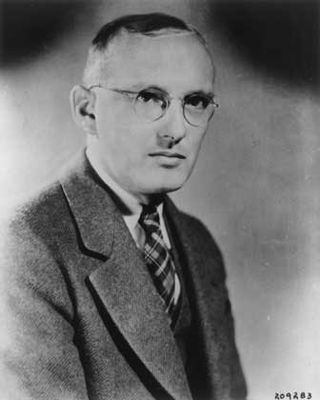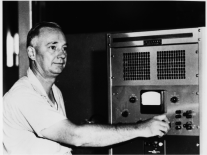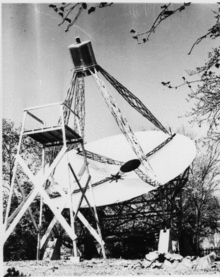
Amateur astronomy is a hobby where participants enjoy observing or imaging celestial objects in the sky using the unaided eye, binoculars, or telescopes. Even though scientific research may not be their primary goal, some amateur astronomers make contributions in doing citizen science, such as by monitoring variable stars, double stars, sunspots, or occultations of stars by the Moon or asteroids, or by discovering transient astronomical events, such as comets, galactic novae or supernovae in other galaxies.

A radio telescope is a specialized antenna and radio receiver used to detect radio waves from astronomical radio sources in the sky. Radio telescopes are the main observing instrument used in radio astronomy, which studies the radio frequency portion of the electromagnetic spectrum emitted by astronomical objects, just as optical telescopes are the main observing instrument used in traditional optical astronomy which studies the light wave portion of the spectrum coming from astronomical objects. Unlike optical telescopes, radio telescopes can be used in the daytime as well as at night.
Timeline of telescopes, observatories, and observing technology.

Radio astronomy is a subfield of astronomy that studies celestial objects at radio frequencies. The first detection of radio waves from an astronomical object was in 1933, when Karl Jansky at Bell Telephone Laboratories reported radiation coming from the Milky Way. Subsequent observations have identified a number of different sources of radio emission. These include stars and galaxies, as well as entirely new classes of objects, such as radio galaxies, quasars, pulsars, and masers. The discovery of the cosmic microwave background radiation, regarded as evidence for the Big Bang theory, was made through radio astronomy.

Karl Guthe Jansky was an American physicist and radio engineer who in April 1933 first announced his discovery of radio waves emanating from the Milky Way in the constellation Sagittarius. He is considered one of the founding figures of radio astronomy.

The Karl G. Jansky Very Large Array (VLA) is a centimeter-wavelength radio astronomy observatory in the southwestern United States. It lies in central New Mexico on the Plains of San Agustin, between the towns of Magdalena and Datil, approximately 50 miles (80 km) west of Socorro. The VLA comprises twenty-eight 25-meter radio telescopes deployed in a Y-shaped array and all the equipment, instrumentation, and computing power to function as an interferometer. Each of the massive telescopes is mounted on double parallel railroad tracks, so the radius and density of the array can be transformed to adjust the balance between its angular resolution and its surface brightness sensitivity. Astronomers using the VLA have made key observations of black holes and protoplanetary disks around young stars, discovered magnetic filaments and traced complex gas motions at the Milky Way's center, probed the Universe's cosmological parameters, and provided new knowledge about the physical mechanisms that produce radio emission.

The National Radio Astronomy Observatory (NRAO) is a federally funded research and development center of the United States National Science Foundation operated under cooperative agreement by Associated Universities, Inc. for the purpose of radio astronomy. NRAO designs, builds, and operates its own high-sensitivity radio telescopes for use by scientists around the world.

The Robert C. Byrd Green Bank Telescope (GBT) in Green Bank, West Virginia, US is the world's largest fully steerable radio telescope, surpassing the Effelsberg 100-m Radio Telescope in Germany. The Green Bank site was part of the National Radio Astronomy Observatory (NRAO) until September 30, 2016. Since October 1, 2016, the telescope has been operated by the independent Green Bank Observatory. The telescope's name honors the late Senator Robert C. Byrd who represented West Virginia and who pushed the funding of the telescope through Congress.

Grote Reber was an American pioneer of radio astronomy, which combined his interests in amateur radio and amateur astronomy. He was instrumental in investigating and extending Karl Jansky's pioneering work and conducted the first sky survey in the radio frequencies.

A directional antenna or beam antenna is an antenna which radiates or receives greater radio wave power in specific directions. Directional antennas can radiate radio waves in beams, when greater concentration of radiation in a certain direction is desired, or in receiving antennas receive radio waves from one specific direction only. This can increase the power transmitted to receivers in that direction, or reduce interference from unwanted sources. This contrasts with omnidirectional antennas such as dipole antennas which radiate radio waves over a wide angle, or receive from a wide angle.

The Stellafane Observatory is an astronomical observatory in Springfield, Vermont, founded in 1920 by Russell W. Porter. The Pink Clubhouse was built in 1923 at the site by the Springfield Telescope Makers Club. The name Stellafane, suggested by Porter at the club's December 1923 meeting, is derived from the Latin words stella and fanum meaning "Shrine to the Stars", and originally referred specifically to the clubhouse, but has since come to refer to all of the club's land and buildings on the summit of Breezy Hill, west of downtown Springfield.

The Molonglo Observatory Synthesis Telescope (MOST) is a radio telescope operating at 843 MHz. It is operated by the School of Physics of the University of Sydney. The telescope is located in Hoskinstown, near the Molonglo River and Canberra, and was constructed by modification of the east–west arm of the former Molonglo Cross Telescope, a larger version of the Mills Cross Telescope. Construction of the original "Super Cross" telescope with 1.6-kilometre arms began in 1960 by Professor Bernard Y. Mills. It became operational in 1967.

The Vassar College Observatory is an astronomical observatory of the private Vassar College, located near the eastern edge of the Poughkeepsie, New York college's campus. Finished in 1865, it was the first building on the college's campus, older even than the Main Building, with which it shares the status of National Historic Landmark. The observatory's significance is due to its association with Maria Mitchell, the first widely known female astronomer in the United States.

Associated Universities, Inc. (AUI) is a research management corporation that builds and operates facilities for the research community. It is a not-for-profit 501(c)(3) corporation headquartered in Washington, D.C., United States. The current president is Adam Cohen. The corporation's major current operating unit is the National Radio Astronomy Observatory, which it operates under a Cooperative Agreement with the National Science Foundation.

The University of Illinois Astronomical Observatory, located at 901 S. Mathews Avenue in Urbana, Illinois, on the campus of the University of Illinois Urbana–Champaign, was built in 1896, and was designed by Charles A. Gunn. It was listed on the National Register of Historic Places on November 6, 1986, and on December 20, 1989, was designated a National Historic Landmark.
Gennady Vasilyevich Potapenko was an American radio astronomer of Russian origin.

The Green Bank Interferometer (GBI) is a former radio astronomy telescope located at Green Bank, West Virginia, U.S., and operated by the National Radio Astronomy Observatory. It included three on-site radio telescopes of 85-foot (26m) diameter, designated 85-1, 85-3, and 85-2 and a portable telescope.

The Green Bank Observatory is an astronomical observatory located in the National Radio Quiet Zone in Green Bank, West Virginia, U.S. It is the operator of the Robert C. Byrd Green Bank Telescope, the world's largest fully steerable radio telescope.

James Moran is an American radio astronomer living in Massachusetts, USA. He was a professor of Astronomy at Harvard University from 1989 through 2016, a senior radio astronomer at the Smithsonian Astrophysical Observatory from 1981 through 2020 and the director of the Submillimeter Array during its construction and early operational phases from 1995 through 2005. In 1998 he was elected to the National Academy of Sciences, in 2010 to the American Academy of Arts and Sciences, and in 2020 to the American Philosophical Society. He is currently the Donald H. Menzel Professor of Astrophysics, Emeritus, at Harvard University.


















